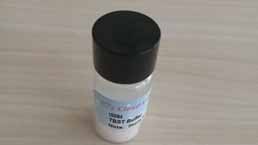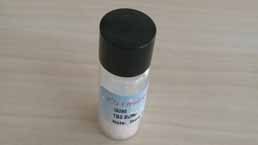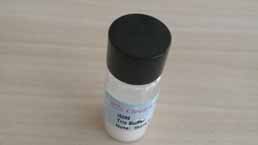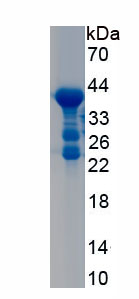Recombinant N-Terminal Pro-Atrial Natriuretic Peptide (NT-ProANP)
NT-Pro-ANP; N-ANP
- Product No.RPA484Hu01
- Organism SpeciesHomo sapiens (Human) Same name, Different species.
- SourceProkaryotic expression
- HostE.coli
- Endotoxin Level<1.0EU per 1µg (determined by the LAL method)
- Subcellular LocationSecreted
- Predicted Molecular Mass40.7kDa
- Accurate Molecular Mass41kDa(Analysis of differences refer to the manual)
- Residues & TagsAla25~Arg123 with N-terminal His and GST Tag
- Buffer FormulationPBS, pH7.4, containing 0.01% SKL, 5% Trehalose.
- Traits Freeze-dried powder
- Purity> 80%
- Isoelectric Point5.7
-
Applications
Positive Control; Immunogen; SDS-PAGE; WB.
If bio-activity of the protein is needed, please check active protein. - DownloadInstruction Manual
- UOM 10µg50µg 200µg 1mg 5mg
- FOB
US$ 160
US$ 400
US$ 800
US$ 2400
US$ 6000
For more details, please contact local distributors!
SEQUENCE

USAGE
Reconstitute in 10mM PBS (pH7.4) to a concentration of 0.1-1.0 mg/mL. Do not vortex.
STORAGE
Avoid repeated freeze/thaw cycles. Store at 2-8°C for one month. Aliquot and store at -80°C for 12 months.
STABILITY
The thermal stability is described by the loss rate. The loss rate was determined by accelerated thermal degradation test, that is, incubate the protein at 37°C for 48h, and no obvious degradation and precipitation were observed. The loss rate is less than 5% within the expiration date under appropriate storage condition.
GIVEAWAYS
INCREMENT SERVICES
-
 BCA Protein Quantification Kit
BCA Protein Quantification Kit
-
 Molecular Mass Marker for Protein
Molecular Mass Marker for Protein
-
 Monoclonal Antibody Customized Service
Monoclonal Antibody Customized Service
-
 Polyclonal Antibody Customized Service
Polyclonal Antibody Customized Service
-
 Protein Activity Test Experiment Service
Protein Activity Test Experiment Service
-
 Immunoprecipitation (IP) Experiment Service
Immunoprecipitation (IP) Experiment Service
-
 TBST Buffer
TBST Buffer
-
 TBS Buffer
TBS Buffer
-
 TRIS Buffer
TRIS Buffer
-
 Spike RBD Protein (S-RBD)
Spike RBD Protein (S-RBD)
-
 Protein G
Protein G
-
 Protein A
Protein A
| Magazine | Citations |
| European Veterinary Conference | Atrial natriuretic peptides detect cardiac dilatation Biblio.ugent: 3227757 |
| Echocardiography | Prediction of postoperative atrial fibrillation with left atrial mechanical functions and NT‐pro ANP levels after coronary artery bypass surgery: A three‐dimensional … Pubmed:29457260 |
| Циррозы печени вирусной этиологии у детей | |
| Van Veterinary Journal | Van Veterinary Journal |
| Journal of the American Heart Association | Recombinant Soluble Corin Improves Cardiac Function in Mouse Models of Heart Failure 33759549 |








